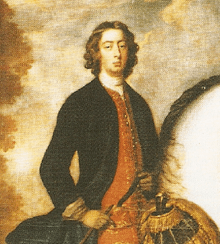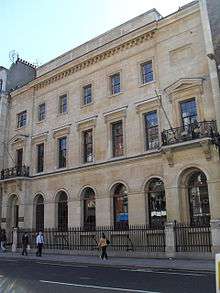C. Hoare & Co
 | |
| Industry | Banking |
|---|---|
| Founded | 1672 |
| Founder | Sir Richard Hoare |
| Headquarters | London, England, UK |
Key people | Alexander S. Hoare |
| Products | Financial services |
Number of employees | 400 |
| Website | www.hoaresbank.co.uk |
C. Hoare & Co. is an English private bank. It is the oldest bank in the United Kingdom and the world's fourth oldest bank. The bank was founded in 1672 by Sir Richard Hoare and remains family-owned; it is currently managed by the 11th generation of Hoare's direct descendants.
The bank provides private banking services that include loans, mortgages and savings accounts, as well as tax and estate planning services. The bank's clients typically are high-net-worth individuals and families.[1]
C. Hoare and Co. has two branches, located at 37 Fleet Street and 32 Lowndes Street in London.[2]
History
.jpg)
17th century
Sir Richard Hoare, the founder of the bank, began his working life apprenticed to a goldsmith.[3] He was granted the Freedom of the Goldsmiths' Company on 5 July 1672.[3] This date marks the foundation of Hoare's Bank, as it was around then that Richard Hoare established his goldsmith's business at the sign of the Golden Bottle in Cheapside, London.[3]
In 1690, Richard Hoare moved the business to new premises in Fleet Street, on the main thoroughfare halfway between the City of Westminster and the City of London, but still within the City of London.[3] He continued trading at the sign of the Golden Bottle (a gilded leather bottle that hung outside the shop): street numbering was unknown in those days, and signs were used to distinguish one business from another.[3]
Goldsmiths had secure premises and had always been the storehouses for cash and valuables, so they were in a unique position to evolve a system of banking: in 1677, some 58 goldsmiths kept "running cashes".[3] They also started to lend their customers' money for interest.[3]
Famous customers of the 17th century:
- Catherine of Braganza (wife of Charles II)[3]
- Samuel Pepys (diarist)[3]
- John Dryden (poet)[4]
- Sir Godfrey Kneller (painter)[5]
- Richard Beau Nash[4]
18th century

During the 18th century, the bank prospered. Richard Hoare was knighted by Queen Anne in 1702 and became Lord Mayor of London in 1712.[6] After Sir Richard's death, two of his sons (Henry, known as "Henry the Good", and Benjamin)[7] continued the business, but it was Sir Richard's grandson, Henry Hoare, who dominated the family through his wealth and personal charisma.[8] Henry was a partner in the bank for nearly 60 years: his nickname of "Henry the Magnificent" derived from his generosity as a great patron of the arts and also from his expenditure on Stourhead in Wiltshire, a country house and estate bought by his father.[9] The gardens were admired as a showplace[10] and, although there is no record of his carrying out work there, Capability Brown, the renowned landscape gardener, was familiar with the garden.[4]
Messrs. Hoare gradually introduced many aspects of modern banking and, in particular, issued printed cheques.[11] Famous customers of the 18th century included:
- Lord North (Prime Minister)[12]
- David Garrick (actor)[13]
- Eton College[4]
19th century
In 1825 William Christmas was convicted of embezzling £1,000 from the bank after he had been dismissed for having an affair with Louisa Chatterley who was "an actress". Christmas was sentenced to be transported for 14 years and his father was asked to make good the bank's losses.[14]
In 1829, the premises at Fleet Street were rebuilt; the new banking house was designed to accommodate the business and a private house.[15] Following the Bank Charter Act 1844, many of the 4,000 or so private banks disappeared.[16] In the first half of the century, Hoares maintained a steady business, latterly under the leadership of Charles Hoare (died 1851), the last senior partner to enjoy the practice of having the name of the bank styled after him.[17] In the second half, the partners running the bank almost brought it down with unsuccessful speculation and poor management. During the middle of the century, there were two partners (Henry of Staplehurst and Peter Richard of Luscombe).[16] Both were deeply religious men but with differing views. Henry was Low Church and Peter Richard was High Church.[16] Owing to their differences, they took it in turns to run the bank, each being in charge for a six-month period.[16] Their sons, who became partners, rebelled against their deeply religious upbringing and proved to be financially unreliable, placing the future of the bank in peril.[16]
Famous customers of the 19th century:
- Lord Byron (poet)[18]
- Jane Austen (author)[16]
20th century

A revival of fortunes for the bank took place in the 20th century, with the early years seeing the credibility of the bank restored.[19] After the First World War, most of the remaining private banks were absorbed by larger banks.[19] Hoares took a decision not to merge and today is the sole survivor as an independent bank. The bank was a partnership until 1929, when the partners adopted its current structure, forming themselves into a private unlimited liability company in which they were the sole shareholders.[19]
During the Second World War, the bank's employees evacuated their offices, including the headquarters at 37, Fleet Street. A fire broke out during an air raid, but thanks to a few brave employees, the historic building was saved.[20]
21st Century
Alexander S. Hoare, the former Chief Executive of the bank, represents the 11th generation to manage C. Hoare & Co. He has been replaced by the first non-family member in an executive position: former head of Credit Suisse Private Bank, Jeremy Marshall.[21]
C. Hoare & Co. announced the sale of its Wealth Management business to Cazenove Capital Management, owned by Schroders, in October 2016.[22] The sale was due to be completed in February 2017.[23]
After the sale of its Wealth Management business in February 2017, C. Hoare & Co. announced in March 2017 the sale of its investment dealing and custody business to Canaccord Genuity Wealth Management.[24]
In popular culture
In Georgette Heyer's 1965 Regency Romance novel The Grand Sophy, Sir Horace Stanton-Lacy, the father of the heroine Sophy, banked with Hoare's.
"My bankers are Hoares" is one of Jack Aubrey's favourite puns in several of the books from the Aubrey-Maturin series by Patrick O'Brian.
In Tahir Shah's 2012 historical novel, Timbuctoo, C. Hoare & Co. were the bankers to The Royal African Committee. Several scenes take place at Hoare's Bank on Fleet Street.[25]
References
- ↑ Merrell, Caroline (2005-10-22). "Billionaires join queue to sign up for bank that likes to say: 'Maybe'". London: The Times. Archived from the original on 2011-06-12. Retrieved 2009-09-23.
- ↑ "In a rich man's world". The Spectator. 8 November 2008. Retrieved 23 September 2009.
- 1 2 3 4 5 6 7 8 9 Victoria Hutchings, Messrs Hoare, Bankers: A History of the Hoare Banking Dynasty (2005), pp. 10-11, 15.
- 1 2 3 4 Henry Peregrine Rennie Hoare, Hoare's Bank: A Record 1672-1955 (1932, new edition 1955), p. 70.
- ↑ Hoare (1932), p. 75.
- ↑ Hutchings, p. 29.
- ↑ Hutchings, p. 37.
- ↑ Hutchings, p. 49.
- ↑ Hutchings, p. 51.
- ↑ Hutchings, p. 55.
- ↑ Hutchings, p. 74.
- ↑ Hoare (1932), p. 79.
- ↑ C. Hoare & Co., A History, p. 6.
- ↑ "Appeal by William Christmas" (PDF). Hoares Bank. Retrieved 10 July 2018.
- ↑ Hutchings, p. 114.
- 1 2 3 4 5 6 C. Hoare & Co., A History, p. 11.
- ↑ Hutchings, p. 126.
- ↑ Hoare (1932), p. 66.
- 1 2 3 C. Hoare & Co., A History, p. 15.
- ↑ "C. Hoare & Co., England's Oldest Private Bank". Wordpress. 18 December 2011. Retrieved 2016-09-06.
- ↑ C. Hoare & Co. - Company Profile. Reference For Business. Accessed 24 September 2009.
- ↑ "Cazenove buys C Hoare & Co's wealth arm". Retrieved 2016-11-16.
- ↑ "Cazenove Capital acquires C Hoare & Co's wealth management arm - Fund Strategy". Fund Strategy. 2016-10-03. Retrieved 2016-11-16.
- ↑ Lobo, Dylan. "C Hoare sells dealing and custody division to Canaccord". Citywire. Retrieved 29 March 2017.
- ↑ Shah, Tahir (June 2012). Timbuctoo (First ed.). London: Secretum Mundi. pp. 42, 177, 179, 347, 391, 392, 398, 399, 400, 503. ISBN 0957242905. Retrieved 16 December 2014.
Further reading
- Henry Peregrine Rennie Hoare, Hoare's Bank: A Record 1672-1955 (1932, new edition 1955)
- Victoria Hutchings, Messrs Hoare, Bankers: A History of the Hoare Banking Dynasty (2005)
- "Service Is Never Out of Fashion". Forbes, 28 November 2005
- "Hoare & Co. Suffers Profits Downturn". Independent, 31 August 2005
- "Good Luck Rubs Off on C. Hoare & Co.", Financial Times, 26 May 2005
- "Hoare Enters the Modern Age". Euromoney, January 2004
- "A History That's Still in the Making", Financial Times, 10 November 2003
- "C. Hoare to Become a 'Manager of Multi-Managers' After 300 Years", Financial Times, 20 October 2003
- "Hoare Welcomes Competitors for the Posh Pound". Independent, 29 May 2001
- "Cashing in on Tradition", The Times, 6 October 1993
External links
| Wikimedia Commons has media related to C. Hoare & Co.. |